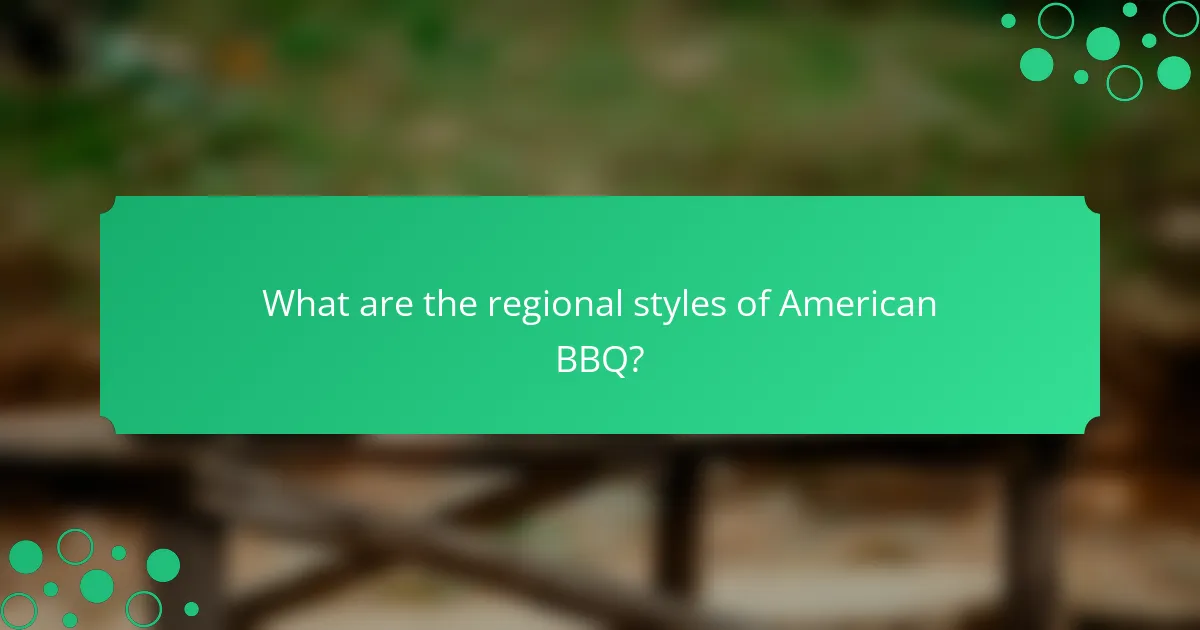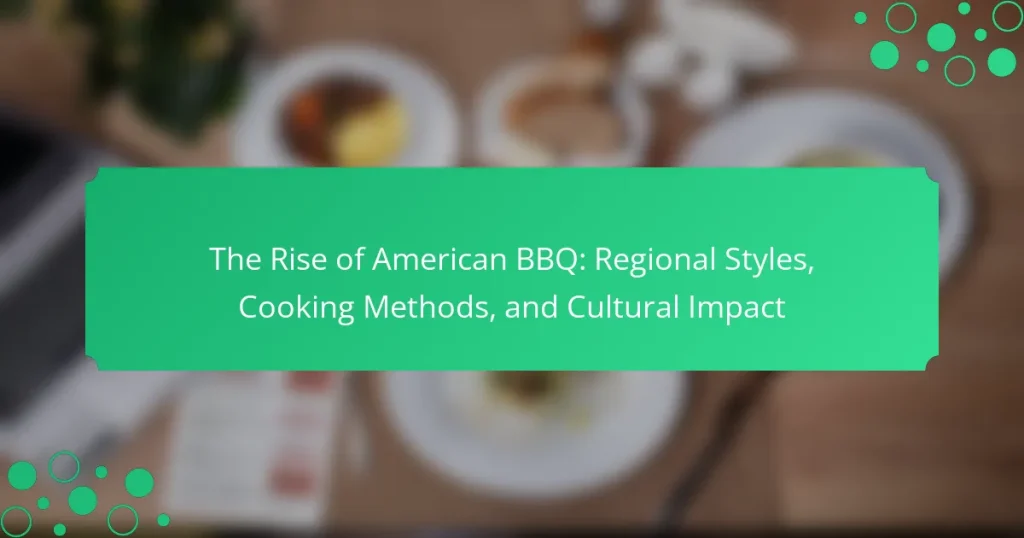American BBQ is a cooking style characterized by slow-cooking meat over indirect heat, often enhanced with wood smoke for improved flavor and tenderness. This culinary tradition varies regionally across the United States, with notable styles such as Texas brisket, Carolina pulled pork, Kansas City ribs, and Memphis BBQ. Each region showcases distinct sauces and rubs that reflect local tastes, with BBQ deeply rooted in cultural significance and communal gatherings. The article explores the diverse flavor profiles and cooking methods associated with American BBQ, highlighting its historical influences and contemporary celebrations, including festivals and competitions that underscore its popularity.

What is American BBQ?
American BBQ refers to a style of cooking meat that involves slow-cooking over indirect heat, often with wood smoke. This method enhances the flavor and tenderness of the meat. American BBQ varies by region, with distinct styles such as Texas brisket, Carolina pulled pork, and Kansas City ribs. Each region employs unique sauces and rubs, reflecting local tastes and traditions. BBQ has deep cultural significance in the U.S., often associated with gatherings and celebrations. Historical records show that BBQ has roots in Native American cooking and has evolved through various influences, including African American culinary traditions. Today, American BBQ is celebrated through festivals and competitions, showcasing its popularity and cultural impact.
How did American BBQ evolve over time?
American BBQ evolved through various cultural influences and regional adaptations. It began with indigenous practices of cooking meat over open flames. European settlers introduced their own techniques and flavors, particularly from the British and Spanish. The method of slow-cooking meats became popular in the Southern states.
In the 19th century, BBQ became a communal event, often tied to celebrations and gatherings. The introduction of grilling and smoking techniques diversified the styles. Regional variations emerged, such as Texas brisket, Carolina pulled pork, and Kansas City ribs.
In the 20th century, BBQ gained national recognition through festivals and competitions. The rise of commercial BBQ restaurants further popularized the cuisine. Today, American BBQ reflects a blend of traditions, showcasing unique flavors and cooking methods across the country.
What are the historical influences on American BBQ?
American BBQ has historical influences rooted in Indigenous, African, and European traditions. Indigenous peoples used slow-cooking methods with local meats. African slaves introduced techniques like smoking and seasoning. European settlers brought their own styles, particularly from the British and Spanish. These influences merged, creating regional variations across the United States. For example, the Carolinas emphasize vinegar-based sauces, while Texas is known for beef brisket. The Great Migration further spread BBQ styles, enhancing its cultural significance. BBQ became a symbol of community and celebration in American culture.
How have regional variations shaped the BBQ landscape?
Regional variations have significantly shaped the BBQ landscape in America. Different regions have developed unique styles based on local ingredients and cultural influences. For example, Texas BBQ is known for its brisket and use of mesquite wood. In contrast, Carolina BBQ often features pulled pork with a vinegar-based sauce. Kansas City is famous for its sweet, tomato-based sauce and a variety of meats. These regional preferences reflect historical settlement patterns and agricultural practices. Additionally, local traditions and community gatherings have influenced BBQ styles. The diversity in BBQ showcases America’s culinary richness and regional identities.
What are the key characteristics of American BBQ?
American BBQ is defined by its diverse regional styles, cooking methods, and distinct flavors. Key characteristics include slow cooking over indirect heat, often using wood or charcoal for flavor. Different regions, such as Texas and Kansas City, showcase unique sauces and meat choices. Texas BBQ emphasizes beef, particularly brisket, while Carolina BBQ favors pork and vinegar-based sauces. Smoking is a crucial technique, imparting deep flavors to the meat. The use of rubs and marinades adds complexity to the taste profile. BBQ is often served with sides like coleslaw and baked beans, enhancing the overall experience. These elements reflect the cultural significance and communal aspect of BBQ in American society.
What types of meats are commonly used in American BBQ?
Commonly used meats in American BBQ include beef, pork, chicken, and turkey. Beef brisket is a popular choice, known for its rich flavor and tenderness when smoked. Pork ribs, particularly baby back and spare ribs, are also widely favored for their juicy meat and smoky taste. Chicken, often prepared as whole birds or wings, absorbs flavors well during grilling or smoking. Turkey, especially smoked turkey breast, is appreciated for its lean meat and versatility. Each of these meats contributes to the diverse flavor profiles found in regional BBQ styles across the United States.
How do flavor profiles differ across regions?

What are the regional styles of American BBQ?
Flavor profiles in American BBQ differ significantly across regions due to local ingredients and cultural influences. In the Carolinas, vinegar-based sauces dominate, imparting a tangy flavor. Texas BBQ emphasizes beef, particularly brisket, with a focus on dry rubs and minimal sauce. Kansas City is known for its sweet and thick tomato-based sauces, often used on various meats. Memphis BBQ highlights pulled pork with a balance of sweet and spicy flavors, often accompanied by a dry rub. Each region’s unique ingredients and cooking techniques contribute to these distinct flavor profiles, reflecting local traditions and tastes.
How does Texas BBQ differ from Carolina BBQ?
Texas BBQ primarily features beef, particularly brisket, while Carolina BBQ is known for its pork, especially pulled pork. Texas BBQ often uses dry rubs and is typically smoked over mesquite or oak wood. In contrast, Carolina BBQ frequently employs vinegar-based sauces, which are used during cooking and as a condiment. The cooking methods also vary; Texas BBQ often utilizes offset smokers for long, slow cooking, while Carolina BBQ may use whole hog cooking techniques. These regional differences reflect the local ingredients and cultural influences in each area. Texas BBQ has a strong emphasis on the meat’s natural flavors, while Carolina BBQ highlights the tangy sauce.
What are the defining features of Texas BBQ?
Texas BBQ is characterized by its emphasis on beef, particularly brisket. This style often features a smoky flavor achieved through long, slow cooking methods. The use of post oak wood is traditional for smoking meats in Texas. Texas BBQ also typically employs a dry rub of spices instead of sauces. Regional variations exist, with Central Texas focusing on meat quality and East Texas often including sauce. The cooking methods are primarily indirect heat and low temperatures, which enhance tenderness. Texas BBQ has gained national recognition for its unique flavors and techniques, influencing BBQ culture across the United States.
What makes Carolina BBQ unique?
Carolina BBQ is unique primarily due to its distinct regional sauces and cooking methods. It features two main styles: Eastern and Western. Eastern Carolina BBQ uses a vinegar-based sauce, emphasizing tanginess. Western Carolina, or Lexington-style, incorporates tomato-based sauces with a hint of sweetness. The cooking method often involves whole hog roasting, which is traditional in Eastern Carolina. Additionally, the use of hickory wood for smoking adds a unique flavor profile. Carolina BBQ is also known for its emphasis on pulled pork, which is a staple in the region. Historical roots trace back to the 18th century, making it a significant part of Southern culinary heritage.
What other regional styles exist in American BBQ?
Regional styles of American BBQ include Texas, Kansas City, Memphis, and Carolina. Texas BBQ is known for its brisket and beef, often smoked over post oak. Kansas City BBQ features a variety of meats, including pork ribs, and is famous for its thick, sweet sauce. Memphis BBQ is renowned for its pulled pork and dry-rubbed ribs, emphasizing a balance of spices. Carolina BBQ is distinct for its vinegar-based sauces and focuses on whole-hog cooking. Each style reflects local traditions and preferences, contributing to the diverse landscape of American BBQ.
What are the characteristics of Kansas City BBQ?
Kansas City BBQ is known for its diverse range of meats and a unique sauce. It features a variety of proteins, including pork, beef, and chicken. The cooking method often involves slow smoking over hickory wood. Kansas City BBQ sauce is typically thick, sweet, and tomato-based. This sauce often includes molasses and brown sugar for added sweetness. The style emphasizes both sweet and spicy flavors. Ribs are particularly popular, often served as spare ribs or baby back ribs. The city hosts the American Royal BBQ competition, showcasing its significance in barbecue culture.
How does Memphis BBQ stand out?

What cooking methods are used in American BBQ?
Memphis BBQ stands out due to its unique emphasis on pork, particularly pulled pork sandwiches. The cooking method primarily involves slow smoking over a wood fire, often using hickory or fruit woods. Memphis BBQ features a distinctive dry rub, which consists of a blend of spices that enhances the meat’s flavor. Additionally, it is known for its use of both dry and wet sauces, allowing for variation in taste. The city hosts the World Championship Barbecue Cooking Contest, which showcases its cultural significance. Memphis BBQ is recognized for its balance of smoke and seasoning, making it a celebrated regional style in American BBQ.
How do smoking and grilling techniques vary?
Smoking and grilling techniques vary primarily in their cooking methods and times. Smoking involves cooking food at low temperatures over an extended period, utilizing wood smoke for flavor. This process can take several hours to even days, depending on the type of meat. Grilling, on the other hand, cooks food quickly at high temperatures, often over direct heat. This method typically requires only a few minutes to cook items like burgers or vegetables.
The flavor profiles also differ significantly. Smoking imparts deep, rich flavors from the wood used, while grilling enhances the natural flavors of the food, often with a charred taste. The equipment used for each technique also varies. Smokers are designed to maintain low temperatures and circulate smoke, while grills are built for high heat and direct cooking.
In the context of American BBQ, these techniques reflect regional preferences and cultural influences. For instance, Texas BBQ often emphasizes smoking brisket, while Kansas City BBQ features a mix of grilling and smoking styles.
What types of wood are commonly used for smoking?
Hickory, mesquite, apple, cherry, and oak are commonly used woods for smoking. Hickory provides a strong flavor and is popular in Southern BBQ. Mesquite burns hot and fast, offering a bold taste, especially in Texas-style BBQ. Apple wood gives a mild and sweet flavor, suitable for poultry and pork. Cherry wood adds a fruity taste and enhances color in smoked meats. Oak is versatile, providing a balanced flavor that works well with various meats. These woods are preferred for their unique flavor profiles and availability in the United States.
How does cooking time affect flavor and tenderness?
Cooking time significantly affects flavor and tenderness in food. Longer cooking times often enhance flavor by allowing spices and seasonings to penetrate the meat. This process can create deeper, more complex flavors. Additionally, extended cooking breaks down connective tissues in tougher cuts of meat. This breakdown results in increased tenderness, making the meat easier to chew. Conversely, insufficient cooking time can lead to tough and chewy textures. Research shows that meats cooked low and slow, such as in BBQ, develop a richer flavor profile and optimal tenderness. For example, brisket typically requires several hours of cooking to achieve the desired results.
What are the benefits of different BBQ cooking methods?
Different BBQ cooking methods offer unique benefits that enhance flavor and texture. Grilling provides a quick cooking time, resulting in a charred exterior and juicy interior. Smoking infuses meats with deep, complex flavors over a longer cooking period. Roasting allows for even heat distribution, producing tender meats and crisp skin. Each method can highlight different cuts of meat, maximizing their potential. For instance, brisket is best suited for low and slow smoking, while steaks thrive on high-heat grilling. The choice of wood in smoking can also impart distinct flavors, such as hickory or mesquite. Understanding these benefits allows cooks to select the best method for their desired outcome.
How does indirect heat differ from direct heat cooking?
Indirect heat cooking involves placing food away from the direct flame, allowing for slower, more even cooking. This method is ideal for larger cuts of meat that require thorough cooking without burning. In contrast, direct heat cooking places food directly over the flame, resulting in faster cooking and a charred exterior. Direct heat is commonly used for items like steaks or burgers that benefit from quick searing. Indirect heat is often used in barbecue techniques, where maintaining moisture and flavor is crucial. Both methods are essential in American BBQ, offering different textures and flavors.
What role does temperature control play in BBQ success?
How has American BBQ influenced culture and community?
Temperature control is crucial for BBQ success. It ensures that meat cooks evenly and achieves the desired tenderness. Maintaining the right temperature prevents overcooking or undercooking. For example, low and slow cooking at 225°F to 250°F is ideal for ribs. This method allows collagen to break down, resulting in juicy meat. On the other hand, high temperatures are suitable for searing steaks. Proper temperature management also influences smoke absorption, enhancing flavor. Overall, mastering temperature control is essential for achieving optimal BBQ results.
What social gatherings are centered around BBQ?
Social gatherings centered around BBQ include cookouts, family reunions, and tailgate parties. Cookouts often involve grilling meats and sharing side dishes among friends and family. Family reunions frequently feature BBQ as a central meal, bringing together relatives for a communal feast. Tailgate parties are popular at sporting events, where attendees grill and enjoy BBQ before games. These gatherings emphasize social interaction and community bonding. BBQ festivals also celebrate regional styles and attract large crowds, showcasing various cooking methods and flavors. Each type of gathering fosters a sense of togetherness and enjoyment through shared food experiences.
How has BBQ contributed to regional identities in the U.S.?
What are some tips for mastering American BBQ at home?
BBQ has significantly shaped regional identities in the U.S. through its diverse styles and cooking methods. Each region showcases unique flavors and techniques, reflecting local culture and history. For instance, Texas is known for its beef brisket, while North Carolina specializes in pulled pork with vinegar-based sauces. Kansas City is famous for its sweet, tomato-based sauces and a variety of meats. The distinct BBQ traditions contribute to a sense of community and pride among residents. Festivals and competitions further celebrate these regional styles, reinforcing local identities. BBQ acts as a cultural touchstone, bringing people together and highlighting the uniqueness of each area.
American BBQ is a culinary style characterized by slow-cooking meat over indirect heat, often enhanced with wood smoke, resulting in diverse regional flavors and techniques. This article explores the evolution of American BBQ, detailing its historical influences from Indigenous, African, and European traditions, and highlighting regional variations such as Texas brisket, Carolina pulled pork, and Kansas City ribs. Key attributes of American BBQ, including cooking methods, flavor profiles, and commonly used meats, are examined, alongside the cultural significance of BBQ in American society and its role in community gatherings. The article also provides insights into mastering BBQ at home, emphasizing the importance of temperature control and cooking methods.




